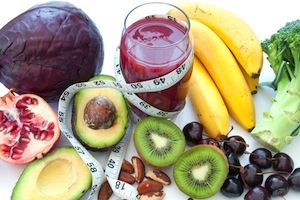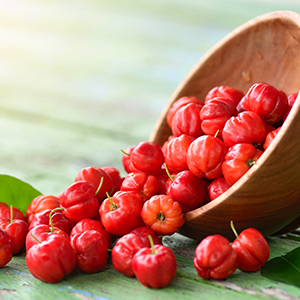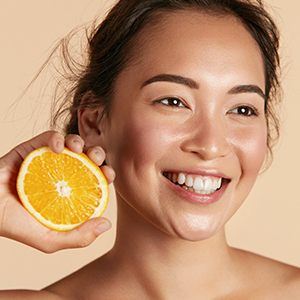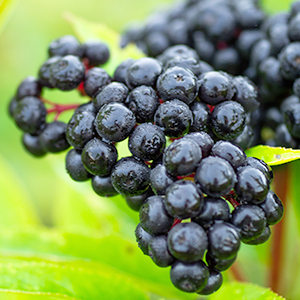
The term "superfood" has been used to describe practically every natural food and health food item under the sun these past few years. With the term’s constant use (and misuse) in advertising, food marketing, and the media, it’s no wonder why there is so much confusion surrounding superfoods. The term isn’t regulated and can be attributed to practically anything – a fact that many big-name food product manufacturers take pleasure in exploiting.
What Is a Superfood?
Perhaps the best definition we can use to describe a superfood is: a nutrient-dense, antioxidant-rich, natural-food product that is minimally processed and bioavailable in numerous, potent nutritive constituents. In other words, superfoods are natural foods that contain a hefty amount of raw nutrition and are highly active in various phytochemical and flavonoid compounds (antioxidants). Blueberries, for example, are often referred to as a superfood because of its low-caloric content and high-antioxidant activity.
Be Wary of Impostors
A word of warning: processed "health" food companies may use the superfood label to market their product if it contains plant-based ingredients. True superfoods, however, are minimally processed in order to retain their nutrient quality and don’t usually have an extensive list of ingredients on their packaging. In fact, the best superfoods don't even come in packaging. Dark, leafy greens, colorful vegetables and fruits, nuts, seeds, seaweed – all of these natural plant foods are highly nutritious and are known as superfoods. Even beverages like green tea and kombucha can be considered superfoods, as they present a number of beneficial antioxidants, probiotics, and other highly valuable compounds.
The Benefits of Superfoods
Superfoods have gained momentum in the field of nutrition research these last few years. An increasing number of herbs, plants, seeds, and other unprocessed foods are beginning to show promise for alleviating a variety of health issues. Since superfoods are usually loaded with antioxidants, they may be helpful for fighting disease, delaying the aging process, and keeping systemic redness at bay. [1] [2] [3] Some superfoods, because of their nutrient content, may also be helpful for promoting cardiovascular health and normal blood sugar. Disbarring food sensitivities, superfoods contain a vast array of benefits with little to no side effects following their consumption.
5 Superfoods You Should Be Eating
There are literally thousands of known superfoods and many more that are waiting to be discovered. Here are 5 superfoods – all of which offer proven health benefits.
1. Mulberries
Often found in temperate climates, mulberries have been used in traditional medicine for centuries. Modern research has revealed that these sweet berries contain a high amount of anthocyanin activity, potent compounds that act as antioxidants. [4] Mulberries have also displayed positive effects on blood sugar. [5]
2. Goji Berries
Consumed by cultures all over the world for centuries, goji berries have experienced a recent surge in popularity. These berries stimulate the immune system by encouraging white blood cell count. [6] Goji berries are also high in antioxidants and have excellent promise against certain degenerative ailments. [7]
3. Chia Seeds
While chia seeds are high in antioxidants, they are more revered for their weight loss and blood sugar-stabilizing benefits. [8] [9] The high fiber content contained within the seeds may regulate blood sugar following a carbohydrate-rich food. Some research has also shown that the fiber in chia seeds may support healthy weight loss by promoting a long-lasting feeling of fullness. [10] [11]
4. Coconut Water
Coconut water has been called nature's sports drink. It helps rehydrate and replenish the body with electrolytes and carbohydrates following intense physical activity. [12] Animal research has shown that coconut water may increase L-arginine levels in the body, an amino acid that helps cardiovascular health and anxiety response. Coconut water has also shown to offer positive effects on lipid levels, prompting many professionals to speculate its potential therapeutic role in combating heart disease. [13]
5. Golden Berries
Often mistaken for golden raisins, golden berries have seen a spike in interest in the nutrition and medical communities. Golden berries modulate blood sugar levels following carbohydrate ingestion. [14] Also, the sweet berry may decrease redness and swelling in the body. [15] [16] Golden berries have exhibited positive benefits for the liver, possibly through its antioxidant qualities. [17]
One Final Thought
Don’t fall for marketing ploys by companies simply wishing to sell you their supposed health-food product. Superfoods should be minimally processed and resemble their natural state as much as possible. By keeping this rule of thumb in mind, you can be sure you are consuming a quality product high in valuable vitamins, minerals, and antioxidants.
References (17)
- Nishino H, Tokuda H, Satomi Y, Masuda M, Osaka Y, Yogosawa S, Wada S, Mou XY, Takayasu J, Murakoshi M, Jinnno K, Yano M. Cancer prevention by antioxidants. Biofactors. 2004;22(1-4):57-61.
- Obrenovich ME, Li Y, Parvathaneni K, Yendluri BB, Palacios HH, Leszek J, Aliev G. Antioxidants in health, disease and aging. CNS & Neurological Disorders - Drug Targets. 2011 March;10(2):192-207.
- Grimble RF. Nutritional antioxidants and the modulation of inflammation: theory and practic. New Horizons. 1994 May;2(2):175-85.
- Imran M, Khan H, Shah M, Khan R, Khan F. Chemical composition and antioxidant activity of certain Morus species. Journal of Zhejiang University - Science B. 2010 December;11(12):973-80. doi: 10.1631/jzus.B1000173.
- Kimura T, Nakagawa K, Kubota H, Kojima Y, Goto Y, Yamagishi K, Oita S, Oikawa S, Miyazawa T. Food-grade mulberry powder enriched with 1-deoxynojirimycin suppresses the elevation of postprandial blood glucose in humans. Journal of Agricultural and Food Chemistry. 2007 July 11;55(14):5869-74.
- Amagase H, Sun B, Nance DM. Immunomodulatory effects of a standarized Lycium barbarum fruit juice in Chinese older healthy human subjects. Journal of Medicinal Food. 2009 October;12(5):1159-65. doi: 10.1089/jmf.2008.0300.
- Bucheli P, Vidal K, Shen L, Gu Z, Zhang C, Miller LE, Wang J. Goji berry effects on macular characteristics and plasma antioxidant levels. Optometry and Vision Science. 2011 February;88(2):257-62. doi: 10.1097/OPX.0b013e318205a18f.
- Martinez-Cruz O, Paredes-López O. Phytochemical profile and nutraceutical potential of chia seeds (Salvia hispanica L.) by ultra high performance liquid chromatography. Journal of Chromatography A. 2014 April 13. pii: S0021-9673(14)00559-7. doi: 10.1016/j.chroma.2014.04.007.
- Ho H, Lee AS, Jovanovski E, Jenkins AL, Desouza R, Vuksan V. Effect of whole and ground Salba seeds (Salvia Hispanica L.) on postprandial glycemia in healthy volunteers: a randomized controlled, dose-response trial. European Journal of Clinical Nutrition. 2013 July;67(7):786-8. doi: 10.1038/ejcn.2013.103.
- Chicco AG, D’Alessandro ME, Hein GJ, Oliva ME, Lombardo YB. Dietary chia seed (Salvia hispanica L.) rich in alpha-linolenic acid improves adiposity and normalises hypertriacylglycerolaemia and insulin resistance in dyslipaemic rats. British Journal of Nutrition. 2009 January;101(1):41-50. doi: 10.1017/S000711450899053X.
- Slavin JL. Dietary fiber and body weight. Nutrition. 2005 March;21(3):411-8.
- Saat M, Singh R, Sirisinghe RG, Nawawi M. Rehydration after exercise with fresh young coconut water, carbohydrate-electrolyte beverage and plain water. Journal of Physiological Anthropology and Applied Human Science. 2002 March;21(2):93-104.
- Sandhya VG, Rajamohan T. Beneficial effects of coconut water feeding on lipid metabolism in cholesterol-fed rats. Journal of Medicinal Food. 2006 Fall;9(3):400-7.
- Pinto Mda S, Ranilla LG, Apostolidis E, Lajolo FM, Genovese MI, Shetty K. Evaluation of antihyperglycemia and antihypertension potential of native Peruvian fuits using in vitro models. Journal of Medicinal Food. 2009 April;12(2):278-91. doi: 10.1089/jmf.2008.0113.
- Martinez W, Ospina LF, Granados D, Delgado G. In vitro studies onthe relationship between the anti-inflammatory activity of Physalis peruviana extracts and the phagocytic process. Immunopharmacology and Immunotoxicology. 2010 March;32(1):63-73. doi: 10.1080/0892397090314957.
- Pardo JM, Fontanilla MR, Ospina LF, Espinosa L. Determining the pharmacological activity of Physalis peruviana fruit juice on rabbit eyes and fibroblast primary cultures. Investigative Ophthalmology and Visual Science. 2008 July;49(7):3074-9. doi: 10.1167/iovs.07-0633.
- El-Gengaihi SE, Hamed MA, Khalaf-Allah Ael-R, Mohammed MA. Golden berry juice attenuates the severity of hepatorenal injury. Journal of Dietary Supplements. 2013 December;10(4):357-69. doi: 10.3109/19390211.2013.830675.
†Results may vary. Information and statements made are for education purposes and are not intended to replace the advice of your doctor. If you have a severe medical condition or health concern, see your physician.







